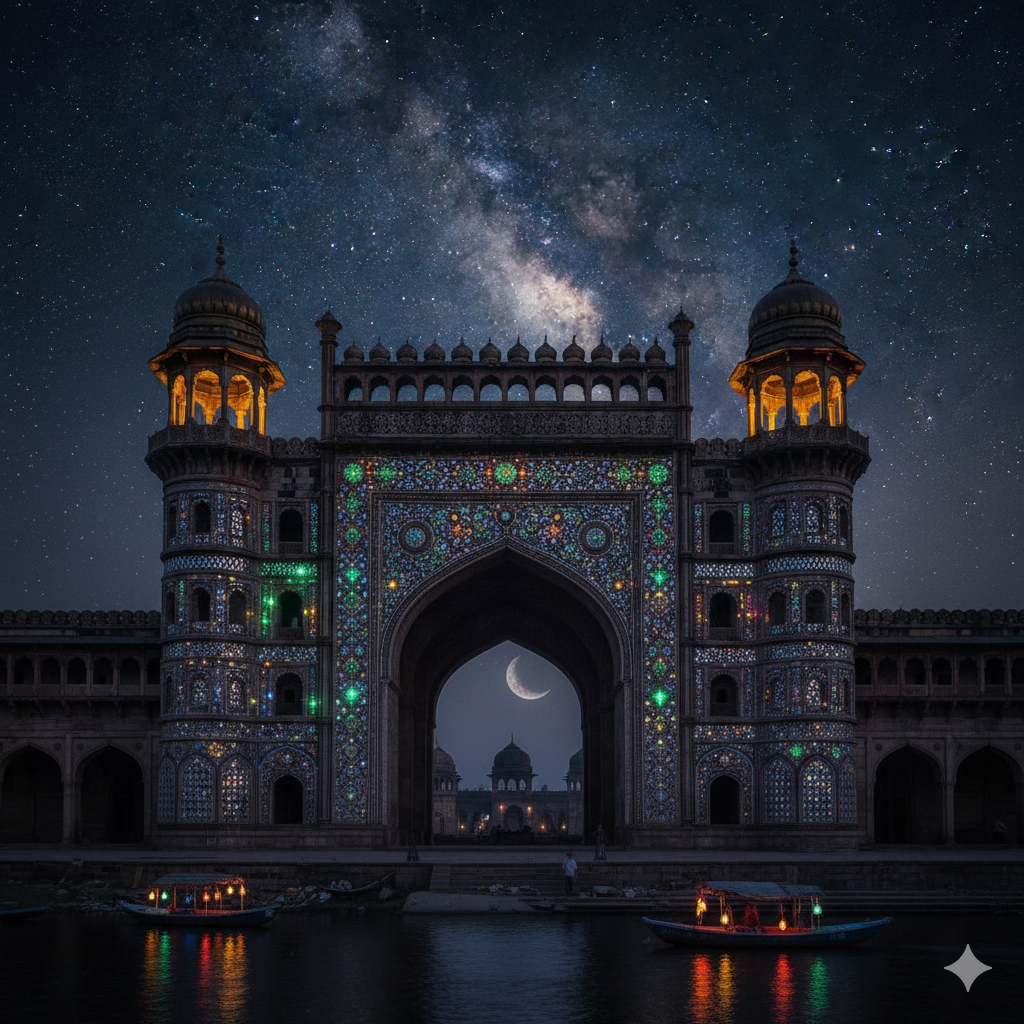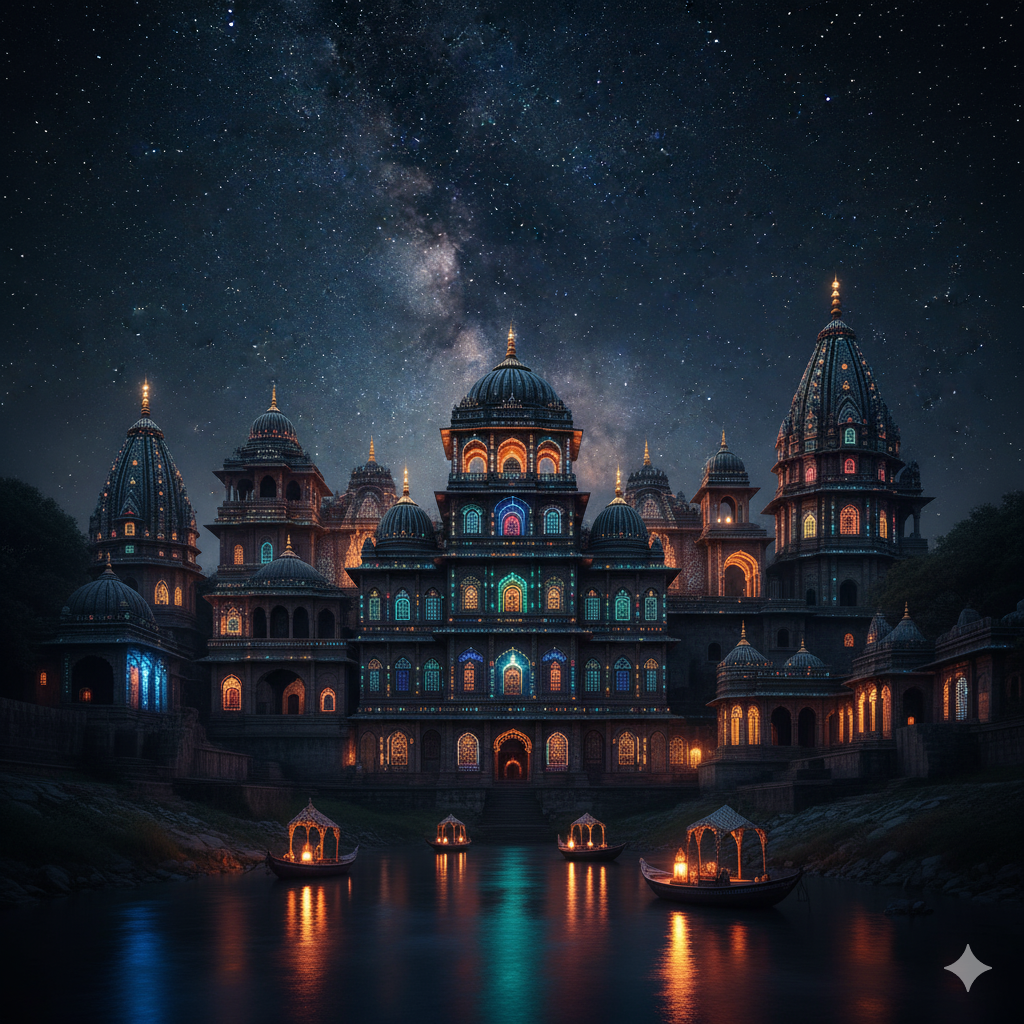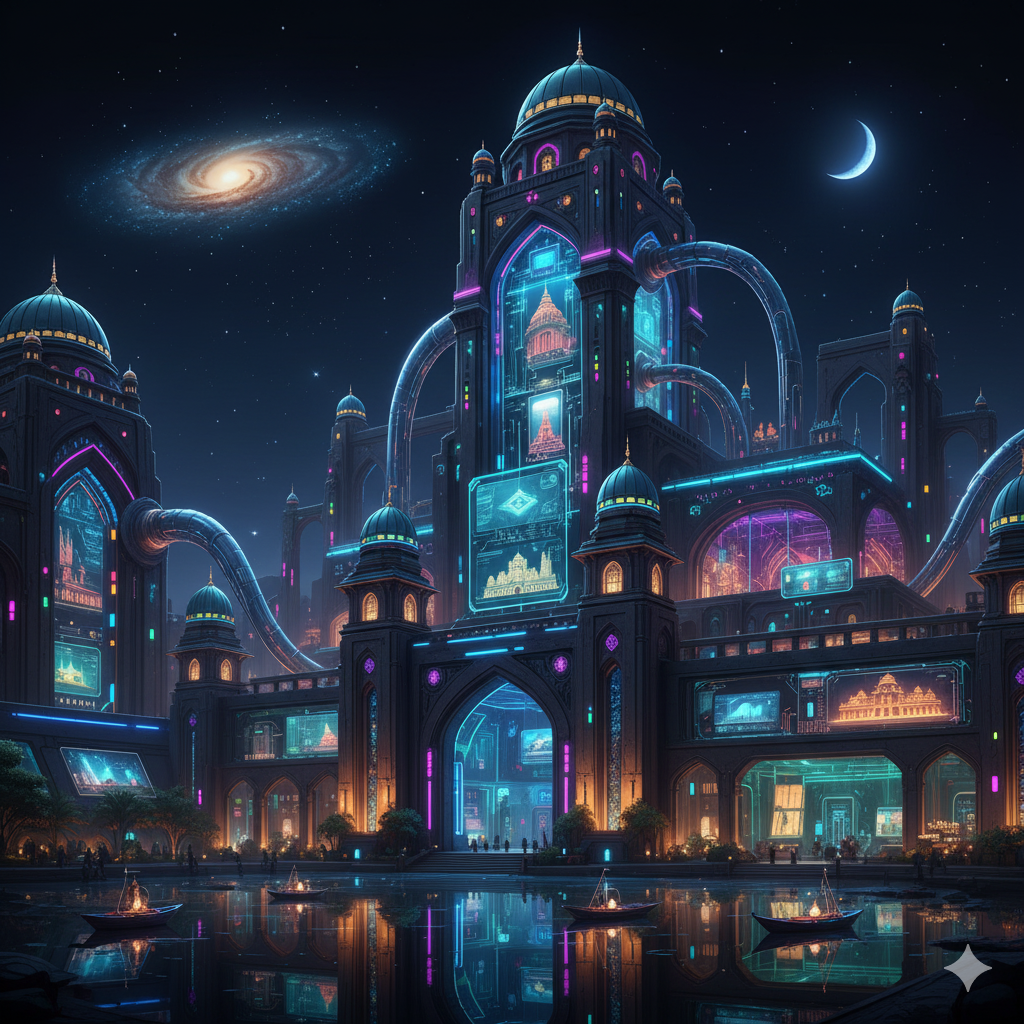Introduction
Prayagraj, known in ancient times as Prayag and later as Allahabad, holds a place of unparalleled importance in the historical, religious, and cultural landscape of India. Situated at the confluence (Triveni Sangam) of three sacred rivers — Ganga, Yamuna, and the mythical Saraswati — Prayagraj has been revered as one of the most sacred tirthas (pilgrimage sites) since Vedic times. It has been described as the “Tirtharaja” — the king of all pilgrimage centers — and has served as a hub of spiritual energy, cultural exchange, and political power through the ages.
The city’s cultural identity is deeply rooted in its geography and mythology, while its enduring legacy in the fields of religion, literature, education, and governance makes it one of the oldest living centers of Indian civilization. This article explores in depth the cultural significance of Prayagraj in ancient India, examining its religious, historical, literary, educational, and socio-political dimensions.
1. Geographical and Historical Setting of Prayagraj
Location and Geographical Importance
Prayagraj is located in the southern part of Uttar Pradesh, at the meeting point of the Ganga and Yamuna rivers, with the invisible river Saraswati believed to join them underground. This sacred confluence, known as the Triveni Sangam, forms the spiritual heart of the city.
In ancient Indian geography, Prayag occupied a central place — lying at the crossroads of the Aryavarta, the land of the Aryans, and the Dakshinapath, the southern route. This strategic location made it a key center of pilgrimage, trade, and communication.
Historical Overview
- In Vedic literature, Prayag is mentioned as a sacred site where sages performed sacrifices and rituals to appease the gods.
- During the epic period, it was associated with important events from the Ramayana and Mahabharata.
- In the Mauryan and Gupta periods, Prayag rose to prominence as a political and administrative center.
- By the early medieval period, it became one of the major centers of Hindu learning and pilgrimage.
Thus, from the earliest textual references to the height of classical civilization, Prayagraj remained a cultural epicenter reflecting India’s spiritual and intellectual evolution.
2. Prayagraj in Vedic and Mythological Literature
Prayag in the Vedas
The earliest references to Prayag appear in the Rigveda, which speaks of the confluence of rivers as a site of great sanctity. The Taittiriya Brahmana and Matsya Purana also describe the region as a place where divine rituals were performed. The concept of “Triveni Sangam” represents the union of three divine streams — symbolizing purity, fertility, and spiritual liberation.
Mythological Narratives
In Hindu mythology, Prayag is associated with the creation of the universe. According to the Padma Purana, after the creation, Lord Brahma performed the first yajna (sacrifice) at Prayag, making it the holiest of all tirthas. Therefore, the city is also known as “Brahma Tirtha.”
The Skanda Purana refers to Prayag as “Tirtharaja,” meaning the king of pilgrimage sites, asserting that bathing at the Sangam brings salvation and washes away sins. The Agni Purana also mentions that all other tirthas owe their sanctity to Prayag, which stands at the apex of spiritual geography.
Prayag in the Epics
In the Ramayana, it is said that Lord Rama, Sita, and Lakshmana visited Prayag during their exile and met Sage Bharadwaja at his ashram near the Sangam. This makes Prayag one of the sacred stations in the spiritual geography of the Ramayana.
In the Mahabharata, the Pandavas are believed to have performed penance at Prayag after the great war. The Vana Parva of the Mahabharata explicitly mentions Prayag as a place where the “Ganga and Yamuna embrace each other,” emphasizing its purifying power.
3. Religious and Spiritual Significance
The Triveni Sangam
The Triveni Sangam — the confluence of Ganga, Yamuna, and the invisible Saraswati — is the spiritual nucleus of Prayagraj. Each river symbolizes distinct spiritual attributes:
- Ganga: Purity and liberation
- Yamuna: Love and devotion
- Saraswati: Knowledge and wisdom
The merging of these three symbolizes the union of karma (action), bhakti (devotion), and jnana (knowledge) — the three paths to salvation in Hindu philosophy.
Ritual Practices and Festivals
From ancient times, pilgrims have gathered at the Sangam to perform snan (holy bath) and yajnas (ritual sacrifices). The site’s spiritual magnetism gave rise to the Kumbh Mela, one of the world’s largest religious congregations, celebrated every 12 years. The origin of the Kumbh Mela is linked to ancient legends of the Samudra Manthan (churning of the ocean), when drops of the divine nectar (amrita) are said to have fallen at Prayag and three other places.
Temples and Sacred Sites
While ancient temples at Prayagraj have undergone reconstruction over centuries, several sites have deep historical roots:
- Bharadwaja Ashram: Associated with Sage Bharadwaja, where Rama received guidance.
- Akshayavat (Immortal Banyan Tree): Believed to be indestructible even during the cosmic dissolution (pralaya).
- Saraswati Koop: A sacred well symbolizing the hidden Saraswati river.
These sacred places form part of the cultural landscape of tirtha-yatra, or sacred pilgrimage, that defined ancient Indian religious geography.
4. Prayagraj in Ancient Political and Administrative History
Mauryan Period
During the Mauryan Empire (4th–2nd century BCE), Prayag emerged as a key administrative and trade center. Its strategic location at the river confluence made it a hub for inland navigation and commerce.
The Ashokan pillar, originally erected by Emperor Ashoka, still stands in Prayagraj’s fort area — a remarkable archaeological relic. The inscriptions on the pillar contain Ashoka’s edicts, reflecting the spread of Buddhist philosophy, morality, and governance across India.
Gupta Period
Under the Gupta Empire (4th–6th century CE), Prayag reached new heights of political and cultural significance. It was known as a seat of power and intellectual excellence.
The Prayag Prashasti, composed by the poet Harishena, was inscribed on the Ashokan pillar during the reign of Samudragupta. This inscription is an invaluable historical record describing Samudragupta’s conquests and his vision of an integrated India. It symbolizes Prayag’s role as the center of imperial ideology and cultural consolidation.
Medieval Continuity
Even after the decline of the Guptas, Prayag continued to be a center of religious and cultural activity. It was revered by later dynasties such as the Chandellas, Gahadavalas, and Mughals, who recognized its spiritual significance.
5. Educational and Intellectual Heritage
Centers of Learning
Prayagraj was one of the early centers of Vedic learning and philosophical debate. Ancient texts mention the presence of ashrams, gurukulas, and yajnasalas where Vedic hymns were recited, and various branches of knowledge were taught — from ritual sciences to astronomy and medicine.
Sage Bharadwaja, one of the seven great rishis (Saptarishis), was associated with Prayag. His ashram became a center for knowledge transmission and spiritual discipline. Bharadwaja was a master of Vedic science, medicine, and grammar, and his teachings influenced subsequent generations of scholars.
Role in the Evolution of Indian Thought
Prayag’s spiritual atmosphere fostered a unique synthesis of philosophy and religion. Scholars from different schools — Vedanta, Mimamsa, Sankhya, and Yoga — visited the region to engage in intellectual dialogue.
This tradition of scholarly exchange continued for centuries, making Prayagraj a symbol of India’s intellectual pluralism.
6. Prayagraj in Ancient Art, Architecture, and Literature
Artistic Heritage
The art and architecture of Prayagraj evolved under the influence of its geography and spirituality. The rock-cut caves of Kaushambi (near modern Prayagraj) and remnants of stupas and monasteries reveal the city’s early Buddhist influence.
During the Gupta period, art and sculpture flourished, characterized by refined elegance and spiritual expression — attributes visible in the regional temples and sculptures discovered in archaeological excavations.
Literary References
Prayag finds repeated mention in Puranic literature, classical Sanskrit poetry, and later regional literature.
- In Kalidasa’s Raghuvamsha, Prayag is referred to as the place where King Raghu performed his sacrificial rituals.
- The Padma Purana and Skanda Purana extol its sanctity and beauty.
- Several medieval poets, including Tulsidas, are believed to have drawn inspiration from the spiritual atmosphere of Prayag.
Thus, Prayagraj’s sacred geography became a recurring motif in Indian aesthetic and literary imagination.
7. Cultural and Religious Syncretism
Confluence of Traditions
Just as the rivers meet at the Sangam, Prayagraj has historically been a meeting ground for diverse spiritual traditions. Apart from Vedic rituals, it hosted the spread of Buddhism, Jainism, and later Hindu sects like Shaivism and Vaishnavism.
Archaeological evidence from nearby Kaushambi shows the presence of early Buddhist monasteries. The Chinese traveler Xuanzang (Hiuen Tsang) also mentioned the region in his travel accounts during the 7th century CE, highlighting its spiritual prominence.
Unity in Diversity
This coexistence of multiple traditions created a syncretic cultural identity. The city’s religious life was marked by tolerance, exchange, and the assimilation of new ideas — embodying the broader Indian ethos of “Sarva Dharma Sambhava” (equality of all faiths).
8. Prayagraj as a Pilgrimage and Tirtha Center
The Concept of Tirtha in Indian Culture
In ancient India, tirthas were sacred spaces where the divine and the mortal realms met — symbolizing the crossing from worldly existence to spiritual realization. Prayagraj, being the Tirtharaja, occupied the highest rank in this sacred hierarchy.
Pilgrimage Traditions
From ancient times, pilgrims from across India traveled to Prayag to perform Prayag Snan (ritual bathing), Pinda Daan (ancestral offerings), and Ashwamedha Yajna (royal sacrifices). The Maha Kumbh Mela, which evolved over millennia, represents the culmination of these traditions.
This ritual gathering exemplifies India’s deep-rooted culture of collective spirituality and social unity, where millions converge in pursuit of purification and enlightenment.
9. Socio-Cultural Life in Ancient Prayagraj
Society and Economy
The fertile plains around the Ganga and Yamuna supported a thriving agrarian economy. The city’s strategic location on trade routes also facilitated commerce and craftsmanship. Merchants, artisans, priests, and scholars coexisted, forming a vibrant and multi-layered society.
Festivals and Customs
Ancient texts mention Magh Mela, an annual fair held during the Hindu month of Magha (January–February). Pilgrims gathered to bathe at the Sangam during this period. This festival, older than the Kumbh Mela, symbolizes continuity of tradition from Vedic times to the present.
Women and Social Roles
Texts like the Mahabharata and Puranas suggest that women participated in religious rituals at Prayag. Goddesses like Ganga, Yamuna, and Saraswati symbolize feminine divinity, showing that the cultural identity of Prayagraj was shaped by both male sages and female deities.
10. Prayagraj in the Context of Indian Civilization
Prayagraj’s significance transcended the boundaries of region and time. It served as:
- A spiritual axis, connecting humanity to divinity.
- A cultural melting pot, where diverse traditions flourished.
- A political center, symbolizing imperial unity and governance.
- An educational nucleus, fostering the growth of learning and philosophy.
Its enduring heritage represents the continuity of Indian civilization — where religion, art, knowledge, and ethics interwove to form a holistic worldview.
11. Archaeological and Epigraphic Evidence
Numerous archaeological discoveries testify to Prayagraj’s ancient glory:
- Ashokan Pillar Inscriptions: Carry the edicts of Ashoka and later inscriptions of Samudragupta (Prayag Prashasti).
- Kaushambi Excavations: Reveal remains of ancient fortifications, Buddhist stupas, coins, and pottery.
- Terracotta figurines and seals: Indicate active trade and craftsmanship from the Mauryan to Gupta periods.
These findings confirm that Prayagraj was not only a religious site but also a center of material and artistic culture.
12. Symbolism of Prayagraj in Indian Thought
The symbolism of Prayagraj extends beyond its physical geography:
- The Triveni Sangam represents the union of body, mind, and soul.
- The Akshayavat symbolizes eternal life and regeneration.
- The Yajnas performed here signify the cosmic order (Rta) that sustains the universe.
Thus, Prayagraj embodies the essence of Indian cosmology — a sacred geography where the physical and the metaphysical coexist.
13. Legacy and Continuity
Though centuries have passed, the spiritual and cultural aura of Prayagraj remains unbroken. Modern India still reveres the city as a spiritual capital where ancient traditions are practiced with the same devotion.
The Kumbh Mela, recognized by UNESCO as an Intangible Cultural Heritage of Humanity, continues to attract millions, demonstrating how ancient Indian cultural practices have survived and adapted through time.
Conclusion
Prayagraj’s cultural significance in ancient India cannot be overstated. It was a center of pilgrimage, scholarship, power, and art — a microcosm of the Indian civilization itself. Its sacred geography at the confluence of three rivers mirrored the confluence of faiths, philosophies, and peoples that shaped India’s collective identity.
From Vedic rituals to Gupta inscriptions, from Bharadwaja’s ashram to Ashoka’s edicts, Prayagraj has been a living witness to the evolution of India’s spiritual and cultural consciousness. It continues to remind us that geography, when intertwined with faith and intellect, gives rise to civilization — and in Prayagraj, that civilization still flows like the eternal rivers of the Sangam.




